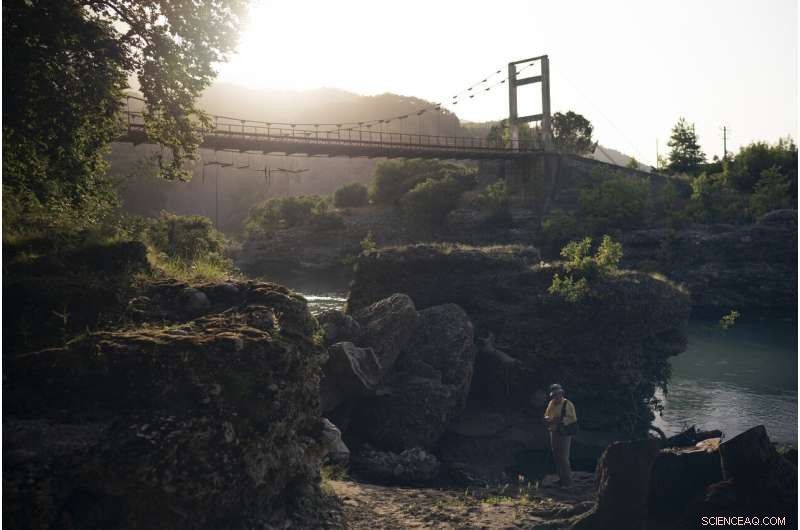
En ce 14 juin, photographies 2019, Jorgji Ilia, 71, se dresse sur la rive de la rivière Vjosa après avoir récupéré de l'eau d'une petite source dans le village de Kanikol, Albanie. "Il n'y a rien de mieux que la rivière, " dit l'instituteur à la retraite. " Le Vjosa donne de la beauté à notre village. " (AP Photo/Felipe Dana)
Sous un large platane près de la frontière entre l'Albanie et la Grèce, Jorgji Ilia remplit un flacon battu de l'une des nombreuses sources de la rivière Vjosa.
"Il n'y a rien de mieux que la rivière, " dit l'institutrice à la retraite. " Le Vjosa donne de la beauté à notre village. "
Le Vjosa est capricieux et inconstant, passant du bleu cobalt translucide au brun boue au vert émeraude, d'un flux constant à un torrent déchaîné. Rien ne le retient sur plus de 270 kilomètres (170 miles) dans son parcours à travers les pentes couvertes de forêts des montagnes grecques du Pinde jusqu'à la côte adriatique albanaise.
C'est l'une des dernières rivières sauvages d'Europe. Mais pour combien de temps ?
Le gouvernement albanais a mis en place des plans pour construire un barrage sur la Vjosa et ses affluents afin de produire de l'électricité indispensable à l'un des pays les plus pauvres d'Europe, avec l'intention de construire huit barrages le long de la rivière principale.
Cela fait partie d'un boom hydroélectrique mondial, principalement en Asie du Sud-Est, Amérique du Sud, Afrique et régions moins développées d'Europe. Rien que dans les Balkans, environ 2, 800 projets d'apprivoisement des rivières sont en cours ou prévus :un « tsunami de barrage, " dit Olsi Nika d'EcoAlbanie, une association qui s'oppose aux projets.
Certains vantent l'hydroélectricité comme un moyen fiable, source d'énergie bon marché et renouvelable qui aide à réduire la dépendance aux combustibles fossiles qui réchauffent la planète comme le charbon, pétrole et gaz naturel. Le Groupe d'experts intergouvernemental sur l'évolution du climat affirme qu'il dispose d'un « potentiel important » pour réduire davantage les émissions de carbone.
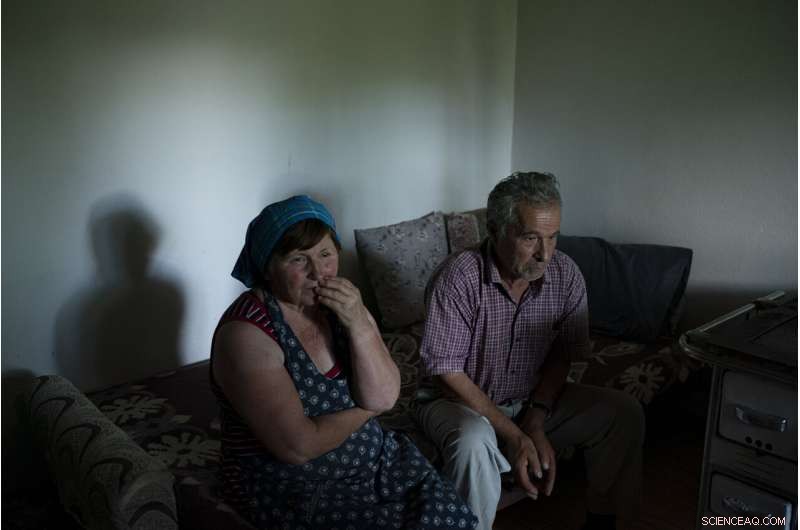
En ce 19 juin, photographies 2019, Jorgji Ilia, 71, un instituteur à la retraite, est assis avec sa femme, Vito, 64, dans leur maison du village de Kanikol, Albanie. "Il n'y a rien de mieux que la rivière, " dit-il. " Le Vjosa donne de la beauté à notre village. " (AP Photo/Felipe Dana)
Mais certaines études récentes remettent en cause l'intérêt de l'hydroélectricité dans la lutte contre le réchauffement climatique. Des critiques tels qu'EcoAlbania affirment que les avantages de l'hydroélectricité sont surestimés et contrebalancés par les dommages que les barrages peuvent causer.
Les rivières sont un élément crucial du cycle mondial de l'eau. Ils agissent comme les artères de la nature, transporter de l'énergie et des nutriments à travers de vastes paysages, fournir de l'eau potable, la production alimentaire et l'industrie. Ils sont un moyen de transport pour les personnes et les marchandises, et un paradis pour les plaisanciers et les pêcheurs. Les rivières abritent une diversité de poissons, notamment de minuscules ménés, la truite et le saumon et fournissent un abri et de la nourriture aux oiseaux et aux mammifères.
Mais les barrages interrompent leur écoulement, et la vie à l'intérieur et autour d'eux. Alors que l'installation d'échelles à poissons et l'élargissement des tunnels pour contourner les barrages aident certaines espèces, cela n'a pas fonctionné dans des endroits comme l'Amazonie, dit Julian Olden, un écologiste de l'Université de Washington qui a étudié les impacts des barrages au Brésil, Australie et États-Unis
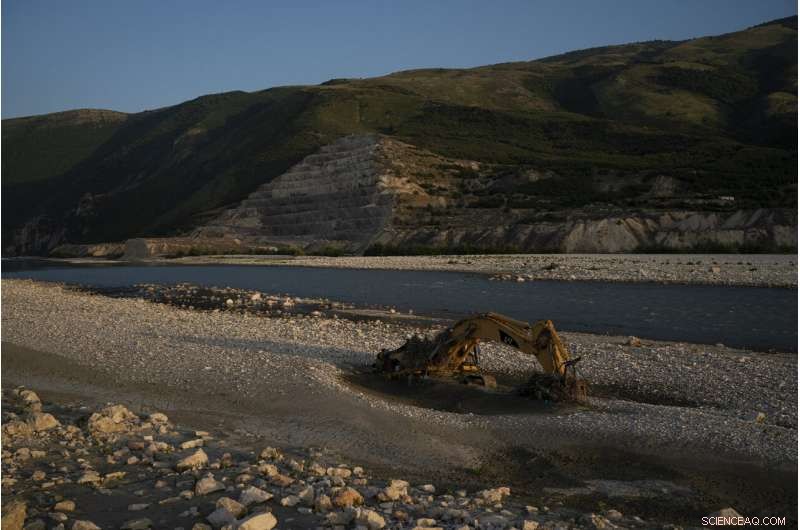
En ce 23 juin, photographies 2019, un bulldozer abandonné se trouve sur les rives de la rivière Vjosa sur le chantier de construction du barrage de Kalivac en Albanie. Certains vantent l'hydroélectricité comme un moyen fiable, source d'énergie bon marché et renouvelable qui aide à réduire la dépendance aux combustibles fossiles qui réchauffent la planète comme le charbon, pétrole et gaz naturel. Mais certains critiques comme EcoAlbania affirment que les avantages de l'hydroélectricité sont surestimés et contrebalancés par les dommages que les barrages peuvent causer. (Photo AP/Felipe Dana)
Les barrages bloquent l'écoulement naturel de l'eau et des sédiments, et peut provoquer des variations de température néfastes. Ils peuvent également modifier la chimie de l'eau et provoquer la croissance d'algues toxiques.
"Une fois les barrages en place, il n'y a presque pas de retour en arrière, " Olden dit. " Vous affamez une rivière d'eau. Il n'est pas surprenant que ses habitants soient susceptibles de disparaître."
Ceux qui vivent le long de la berge ou dépendent de la voie navigable pour leur subsistance craignent que les barrages ne tuent le Vjosa tel qu'ils le connaissent. Son écosystème fragile sera altéré de manière irréversible, et de nombreux résidents perdront leurs terres et leurs maisons.
"C'est comme les humains, " dit Elton Pashollari, un guide de rafting dont les clients sont de plus en plus attirés par la nature sauvage de la Vjosa. "Que se passe-t-il si l'une de vos artères, ça s'arrête, le sang ne circule plus ? C'est la même chose avec le Vjosa."
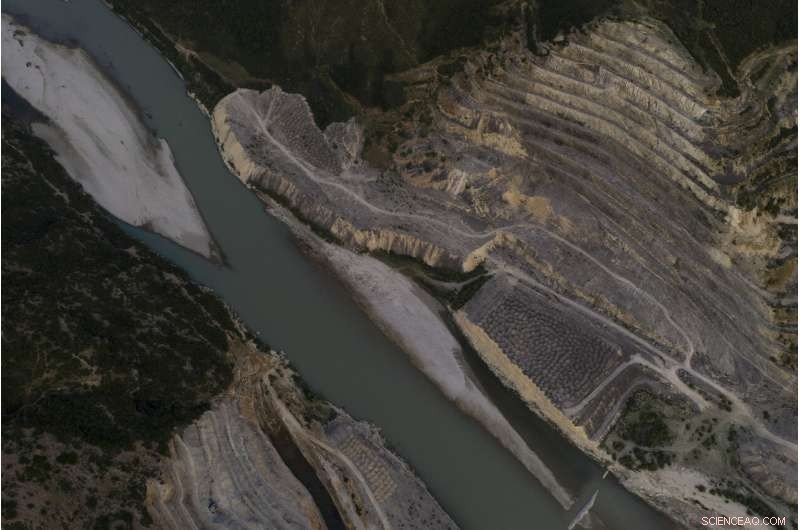
Ce 23 juin, La photo aérienne de 2019 montre le chantier de construction du barrage de Kalivac sur les rives de la rivière Vjosa en Albanie. Alors que la pression pour construire des barrages s'intensifie dans les pays moins développés, l'inverse se produit aux États-Unis et en Europe occidentale, où il y a un mouvement pour démolir des barrages considérés comme obsolètes et destructeurs pour l'environnement. (Photo AP/Felipe Dana)
___
Du platane d'Ilia près de la frontière grecque, la Vjosa coule vers le nord à travers des gorges étroites avant de passer par la ville de Tepelene, s'alanguissant et s'élargissant en larges bancs de gravier, son écoulement se divise en brins, ce que les scientifiques appellent une rivière tressée.
Cette caractéristique est typique des rivières sauvages et est critique pour l'écosystème local. Il crée des habitats diversifiés et permet aux sédiments de s'écouler, fertiliser les plaines inondables et rajeunir le lit de la rivière.
C'est ici que le Vjosa révèle une autre facette de sa nature sauvage. Après les inondations saisonnières, la rivière peut changer de cours, ses tresses se reformant le long du gravier profond qui sert de système de filtrage et d'auto-épuration. Il saute de gauche à droite vers le centre, sur une zone d'environ 1,5 kilomètre (1 mile) de large.
"Une rivière naturelle est une rivière dynamique... une rivière vivante, " says Nika of EcoAlbania. "It's living day by day and it changes its face. After each flood, you could never see the same scenery."
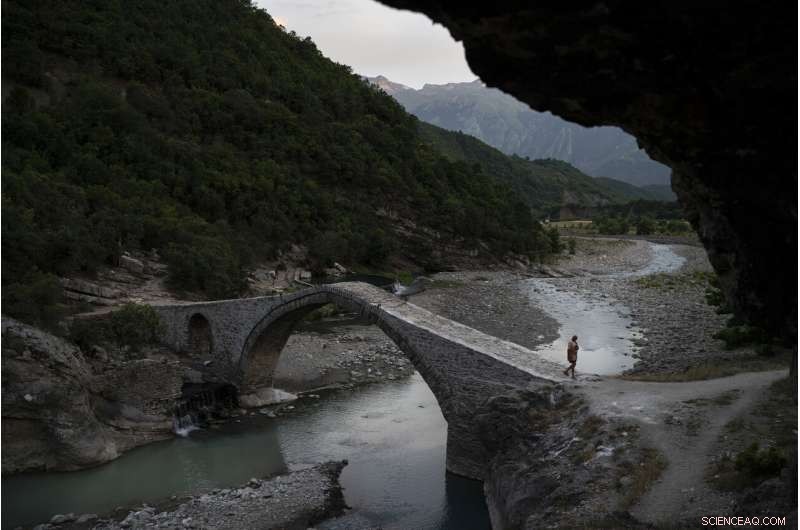
In this June 18, photographies 2019, a man crosses a bridge over the Langarica River, a tributary to the Vjosa near the city of Permet, Albania. Albania's government has set in motion plans to dam the Vjosa and its tributaries to generate much-needed electricity for one of Europe's poorest countries, with the intent to build eight dams along the main river. (AP Photo/Felipe Dana)
The river's ability to clean itself has proved crucial in a country where waste management is often rudimentary. Pendant des années, people have dumped trash in gullies that washed into the river, leaving trails of plastic and cloth clinging to tree branches. Some towns still dump raw sewage, but the river's self-cleansing means that the overall water quality is passable.
About 25 kilometers (16 miles) northwest of Tepelene, the riverbed narrows into another tight, steep gorge teeming with life, where birds swoop from trees anchored precariously in the cliff-face. Just beyond that comes the first sign of how dramatically a dam would affect the river and the life connected to it.
Emerging from the canyon, it looks like a strip mine. This is Kalivac, one of the proposed dam sites. An Italian company was awarded a contract in the late 1990s. Construction began, but never finished, plagued with delays and financial woes. It now lies derelict with guards stationed to prevent looting.
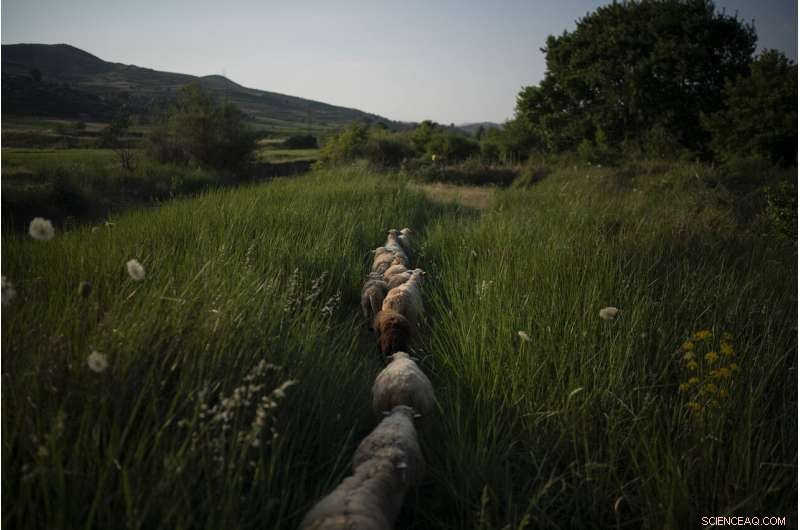
En ce 27 juin, photographies 2019, sheep are pastured near the shore of the Vjosa River in Ane Vjosa, Albania. (AP Photo/Felipe Dana)
Half the hill on one side has been dug away, creating giant steps into the rock. Vehicles sit abandoned, a digging machine sunken into the ground, branches and debris clinging to its frame.
Maintenant, the government has awarded a new contract for the site to a Turkish company.
For Benedikt Baeumler, a German advertising executive kayaking the length of the river, the sight was a shock.
"I felt like there's all this wonderful nature, and then suddenly to see these stairs, like the Egyptian pyramids, " il dit.
A few days earlier and several miles upriver, the 43-year-old had been ambivalent about the hydropower projects, noting his own country had also dammed its rivers.
But what he saw at the Kalivac site changed his mind.
"It was really unbelievable what they did to nature, removing entire parts of the mountain, " il a dit, setting up camp on a sandbar back in June. "I hope this dam is never built."

In this June 28, photographies 2019, Shyqyri Seiti, pulls his fishing net from the Vjosa River near Ane Vjose, Albania. The 65-year-old boatman has been transporting locals, goods and livestock across the river for about a quarter century. The construction of the Kalivac dam would spell disaster for him. Many of the fields and some of the houses in his nearby village of Ane Vjose would be lost. (AP Photo/Felipe Dana)
Many locals agree. Dozens of residents from the village of Kute, further downriver, joined nonprofits to file what was Albania's first environmental lawsuit against the construction of a dam in the Pocem gorge, a short distance downriver from Kalivac. They won in 2017, but the government has appealed.
The victory, while significant, was just one battle. Une semaine plus tard, the government issued the Kalivac contract. EcoAlbania plans to fight that project, trop.
Ecologically, there is a lot at stake.
A 2018 study led by University of Vienna's Fritz Schiemer found the Vjosa was incredibly diverse. The team logged more than 90 types of aquatic invertebrates in the places where dams are planned, plus hundreds of fish, amphibian and reptile species, some endangered and others endemic to the Balkans.
But "the majority of the specific biodiversity will disappear in the case of the planned dam constructions, " they warned.
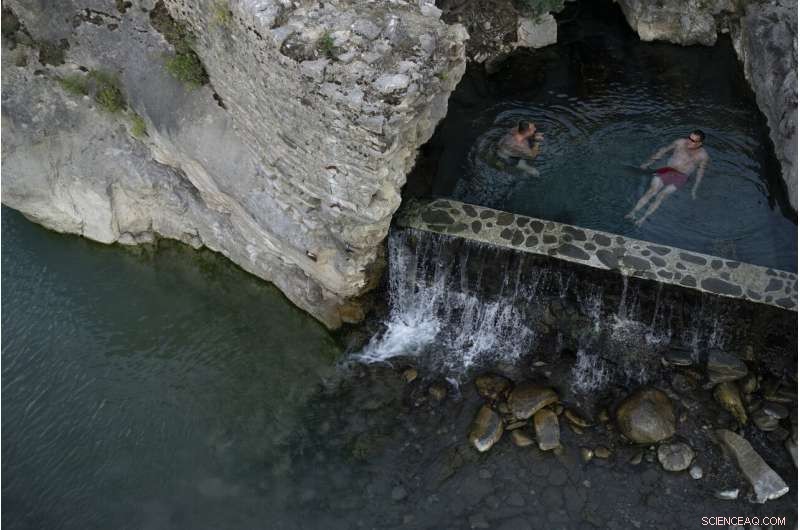
En ce 20 juin, photographies 2019, people bathe in a thermal spring on the banks of the Langarica River, a tributary to the Vjosa near Permet, Albania. (AP Photo/Felipe Dana)
Dams can unravel food chains by reducing populations of insects that feed fish and by limiting spawning, which in turn leaves less prey for fish-eating birds and mammals. But the most well-known problem with building dams is that they block the paths of fish trying to migrate upstream to spawn. The U.S. Atlantic salmon population has plummeted, according to the National Oceanic and Atmospheric Administration, in great part due to dams.
As pressure to build dams intensifies in less developed countries, the opposite is happening in the U.S. and western Europe, where there's a movement to tear down dams considered obsolete and environmentally destructive.
Plus de 1, 600 have been dismantled in the U.S., most within the past 30 years, according to the advocacy group American Rivers. En Europe, the largest-ever removal began this year in France, where two dams are being torn down on Normandy's Selune River.
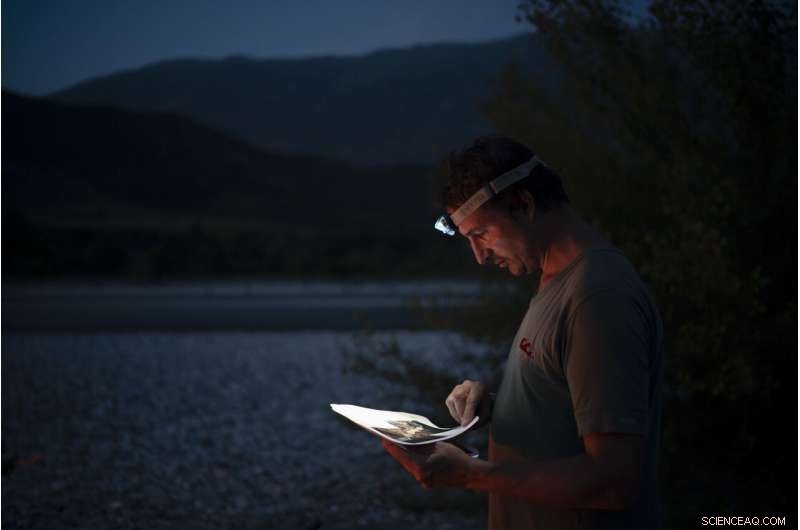
In this June 15, photographies 2019, Benedikt Baeumler, a German advertising executive kayaking the length of the Vjosa River, checks his map after setting up camp on its bank in Albania. A few days earlier and several miles upriver, the 43-year-old had been ambivalent about the hydropower projects, noting his own country had also dammed its rivers. But what he saw at the Kalivac site changed his mind. "It was really unbelievable what they did to nature, removing entire parts of the mountain, " he said. "I hope this dam is never built." (AP Photo/Felipe Dana)
___
With so few wild rivers left around the globe, the Vjosa also is a valuable resource for studying river behavior.
"Science is only at the beginning of understanding how biodiversity in river networks is structured and maintained, " says researcher Gabriel Singer of the Leibniz-Institute in Germany. "The Vjosa is a unique system."
For Shyqyri Seiti, it's much more personal.
The 65-year-old boatman has been transporting locals, goods and livestock across the river for about a quarter century. The construction of the Kalivac dam would spell disaster for him. Many of the fields and some of the houses in his nearby village of Ane Vjose would be lost.
"Pour moi, the river is everything, " he says. "Someone will benefit from the construction of the dam, but it will flood everyone in the area. ... What if they were in our place, how would they feel to lose everything?"
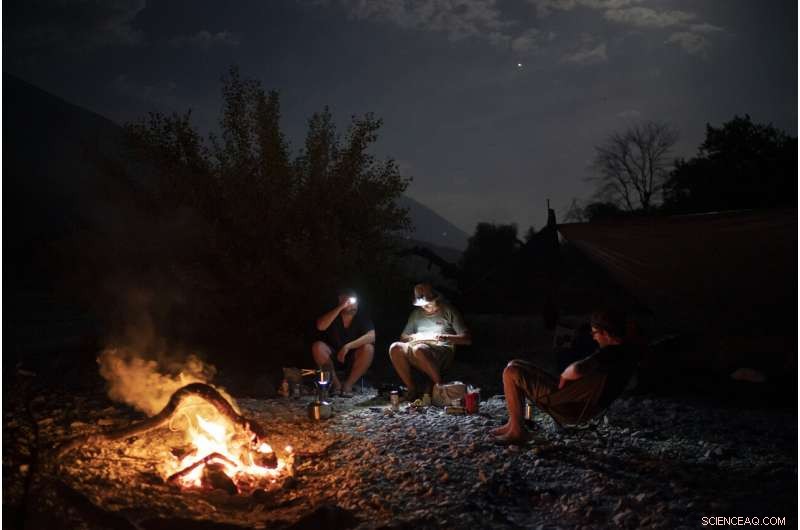
In this June 15, photographies 2019, Jurgen Steinbauer, Benedikt Baumler and Sebastian Baumler, German tourists who are kayaking the length of the Vjosa River, cook a meal as they sit next to a bonfire on the river bank in Albania. After seeing the Kalivac dam construction site, Benedikt Baeumler said, "It was really unbelievable what they did to nature, removing entire parts of the mountain. I hope this dam is never built." (AP Photo/Felipe Dana)
His love for the river runs deep:It feeds his family by providing work and fish to eat and sell. He taught his five children to swim here. Tous les matins, he runs down to the river just to take in the view.
Seiti has protested against the plans, but some of his neighbors disagree. Le maire, Metat Shehu, insists the community "has no interest" in the matter.
"The Vjosa is polluted. The plants and creatures of Vjosa have vanished, " Shehu says while tending his goats. The biggest issue, il ajoute, is that villagers are being offered too little to give up their land. He hopes the dam will bring investment to the area.
About 10 kilometers (6 miles) downriver of Ane Vjose lies the village of Kute, on a hill overlooking the Vjosa as it snakes its way north to the sea. Kute residents joined the lawsuit against the Pocem dam that would flood their fields, some houses and, crucially for many, a cemetery. Relieved by their victory, they now wait anxiously for the outcome of the government's appeal.
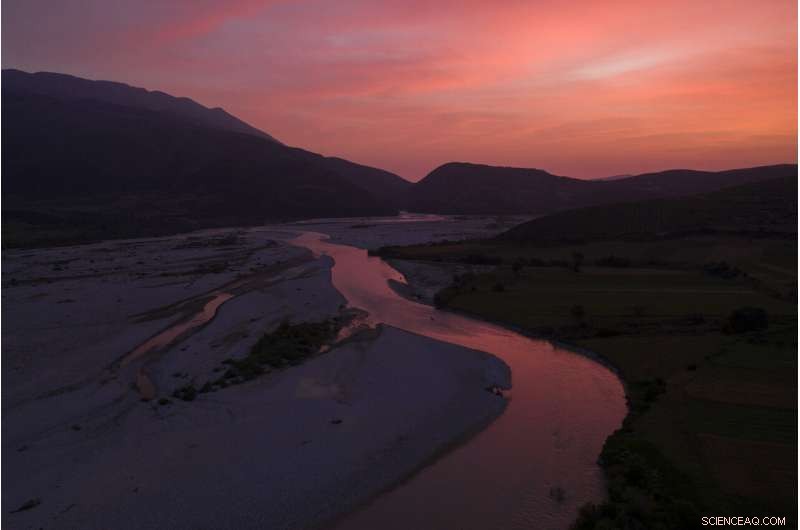
En ce dimanche, 16 juin 2019 aerial photo, the sun sets behind the Vjosa River near Tepelene, Albania. Rivers are a crucial part of the global water cycle. They act like nature's arteries, carrying energy and nutrients across vast landscapes, providing water for drinking, food production and industry. (AP Photo/Felipe Dana)
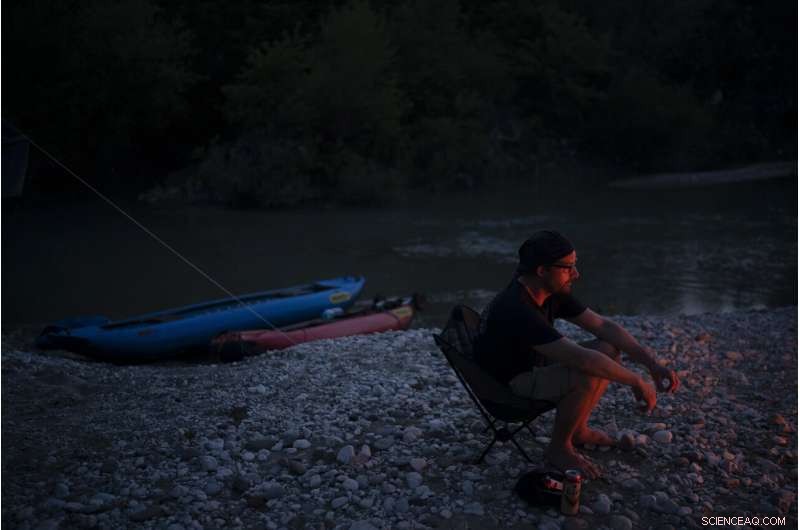
In this June 15, photographies 2019, Sebastian Bäumler, 41, a German filmmaker kayaking the length of the Vjosa River, is illuminated by a bonfire as he sits next to his kayak on its bank in Albania. (AP Photo/Felipe Dana)
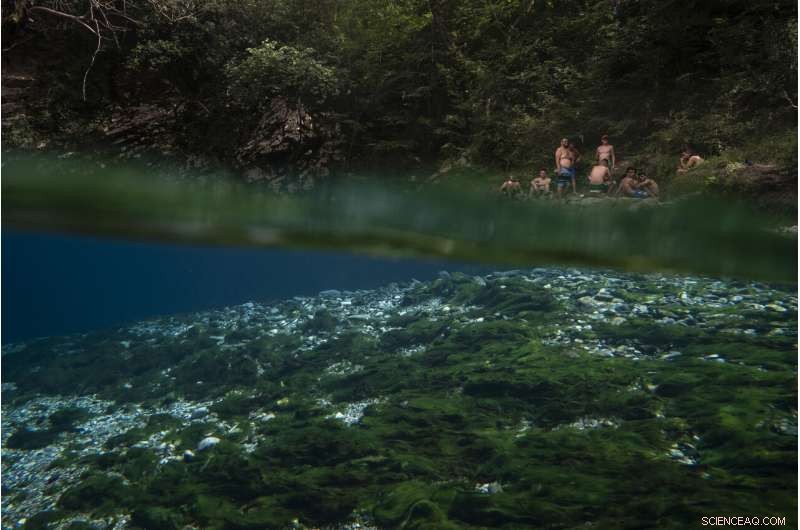
In this June 24, photographies 2019, residents sit on the shore of the Vjosa River next to a spring in the Kelcyre Gorge, Albania. Those who live along the riverbank or rely on the waterway for their livelihood fear dams could kill the Vjosa as they know it. Its fragile ecosystem will be irreversibly altered, and many residents will lose their land and homes. (AP Photo/Felipe Dana)
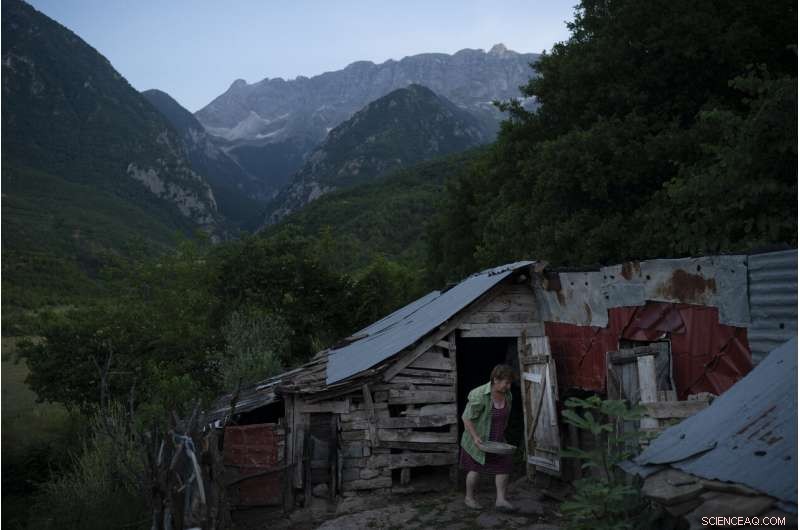
In this June 19, photographies 2019, Vito Ilia, 64, walks out of a small cow shed outside her home in the village of Kanikol, Albania. (AP Photo/Felipe Dana)
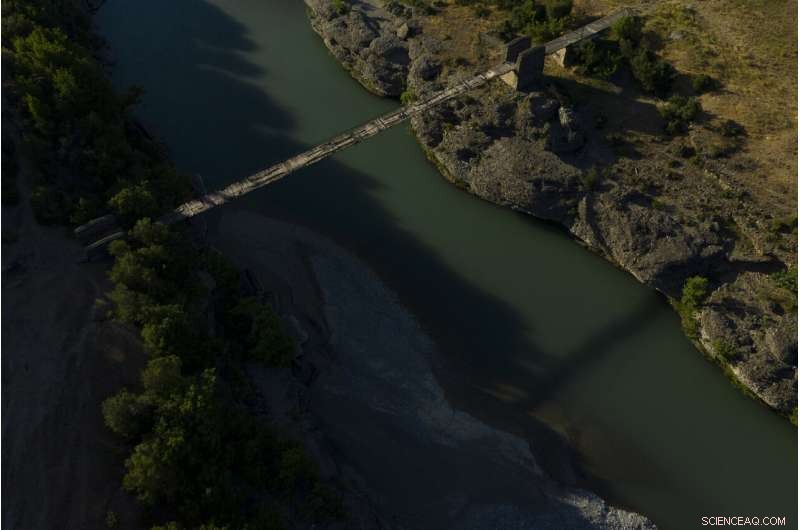
In this June 30, photographies 2019, an old bridge spans the Vjosa River near the border with Greece, in Albania. (AP Photo/Felipe Dana)
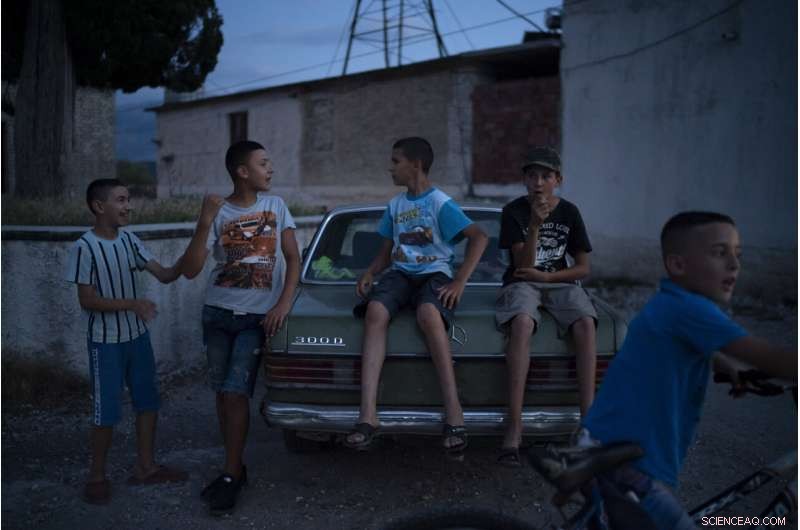
In this June 26, photographies 2019, children play outside at dusk in the village of Kute, Albania. The village overlooks the Vjosa River as it snakes its way north to the sea. Residents here joined a lawsuit against the Pocem dam that would flood their fields, some houses and, crucially for many, a cemetery. (AP Photo/Felipe Dana)
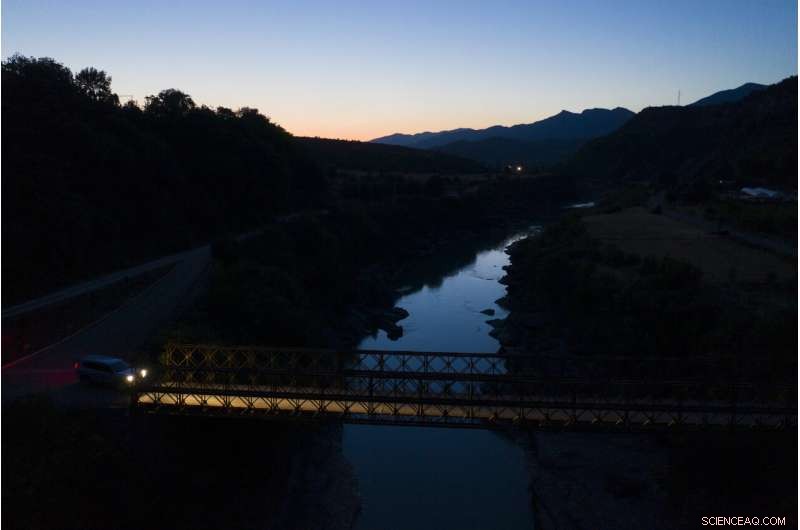
In this June 30, photographies 2019, the sky is reflected in the Vjosa River after sunset near the village of Badelonje, Albania. Rivers are a crucial part of the global water cycle. They act like nature's arteries, carrying energy and nutrients across vast landscapes, providing water for drinking, food production and industry. (AP Photo/Felipe Dana)
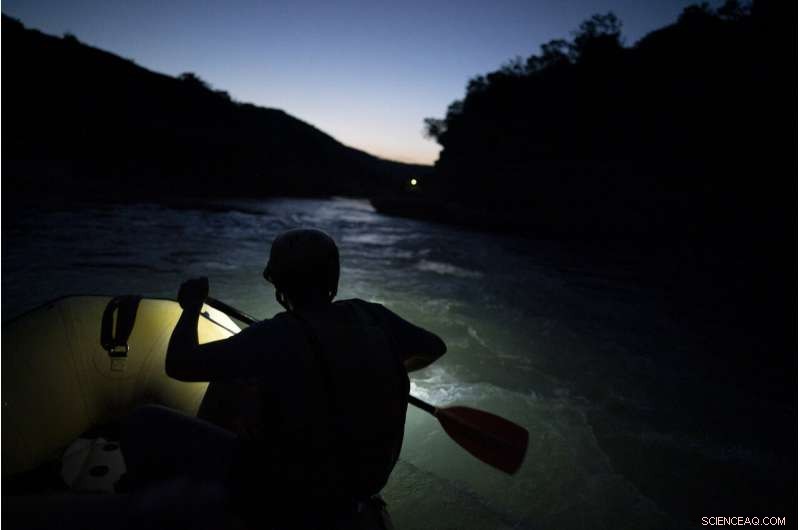
En ce 29 juin, photographies 2019, a river rafting guide paddles at dusk on the Vjosa River, Albania. Those who live along the riverbank or rely on the waterway for their livelihood fear dams could kill the Vjosa as they know it. Its fragile ecosystem will be irreversibly altered, and many residents will lose their land and homes. (AP Photo/Felipe Dana)
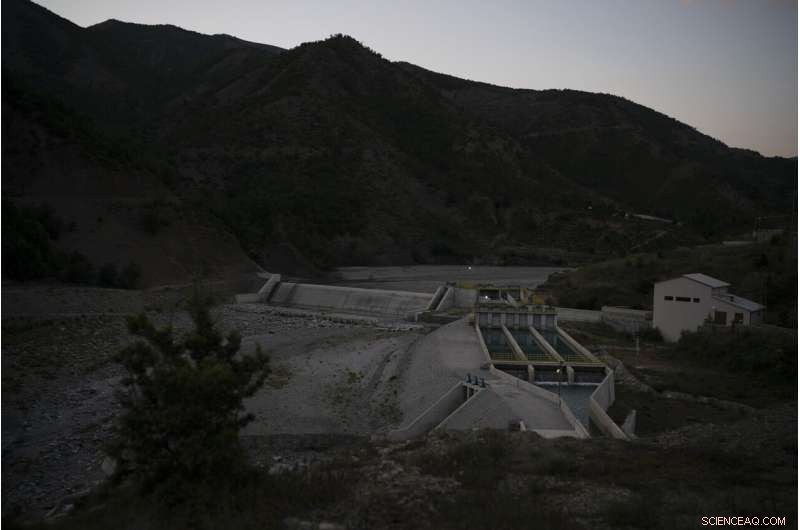
This June 20, 2019 photo shows the Langarica hydropower plant, on a tributary to the Vjosa River near Permet, Albania. As pressure to build dams intensifies in less developed countries, the opposite is happening in the U.S. and western Europe, where there's a movement to tear down dams considered obsolete and environmentally destructive. (AP Photo/Felipe Dana)
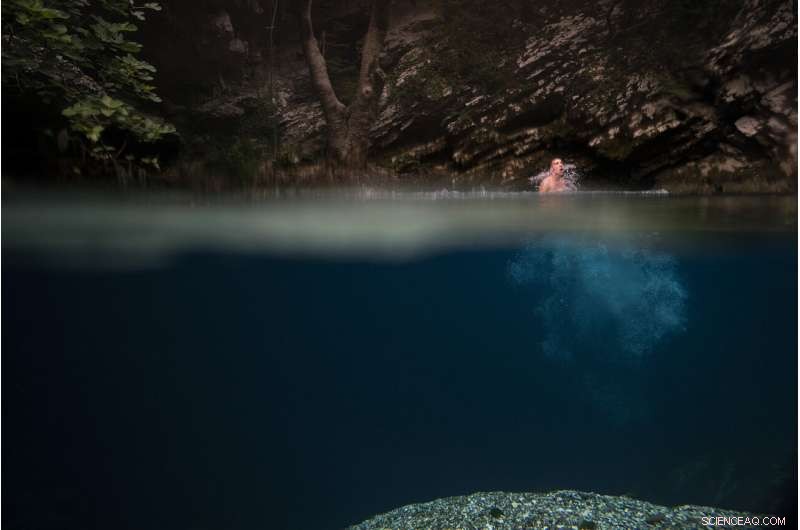
In this June 24, photographies 2019, a man jumps into a spring where it meets the Vjosa River in the Kelcyre Gorge, Albania. Albania's government has set in motion plans to dam the Vjosa and its tributaries to generate much-needed electricity for one of Europe's poorest countries, with the intent to build eight dams along the main river. (AP Photo/Felipe Dana)
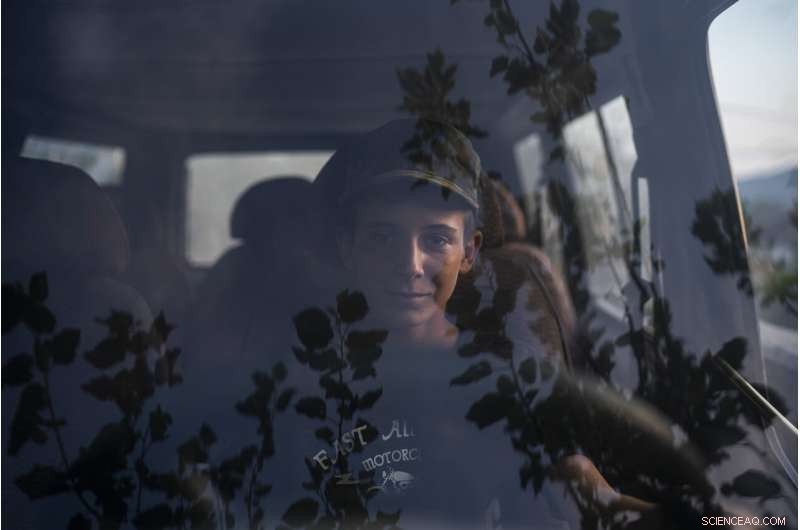
In this June 26, photographies 2019, 13-year-old Eriko, sits in the driver's seat of a car in the village of Kute, Albania. The village overlooks the Vjosa River as it snakes its way north to the sea. Residents here joined a lawsuit against the Pocem dam that would flood their fields, some houses and, crucially for many, a cemetery. (AP Photo/Felipe Dana)
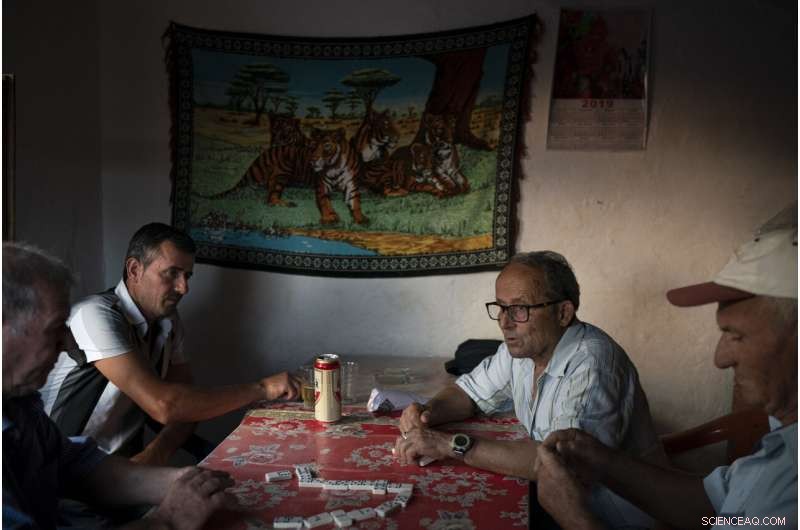
In this June 26, photographies 2019, residents play dominoes in a small bar in the village of Kute, Albania. Dozens of residents from the village joined nonprofit organizations to file what was Albania's first environmental lawsuit against the construction of a dam in the Pocem gorge. They won in 2017, but the government has appealed. (AP Photo/Felipe Dana)
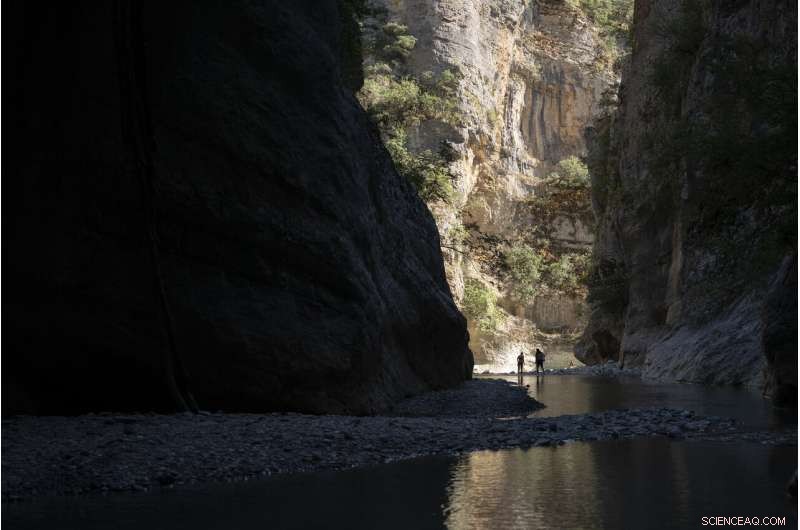
En ce 20 juin, photographies 2019, people walk along the Langarica River, a tributary to the Vjosa near Permet, Albania. Albania's government has set in motion plans to dam the Vjosa and its tributaries to generate much-needed electricity for one of Europe's poorest countries, with the intent to build eight dams along the main river. (AP Photo/Felipe Dana)
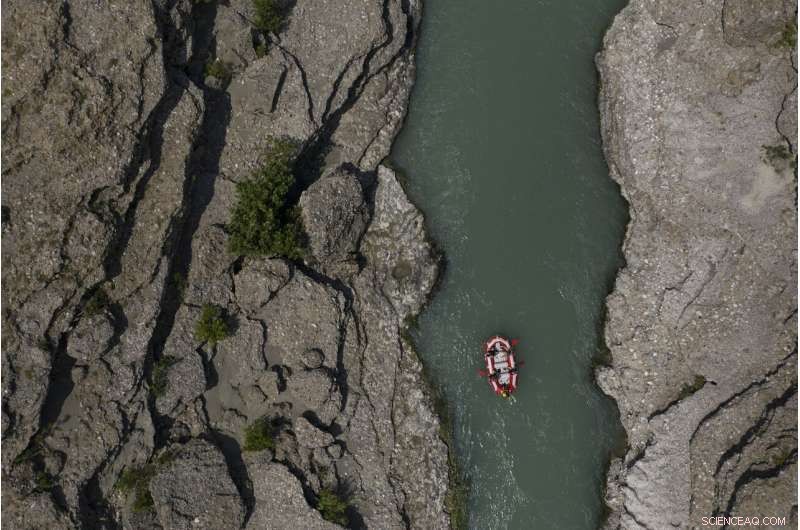
In this June 25, photographies 2019, people raft on the Vjosa River near Permet, Albania. Some tout hydropower as a reliable, cheap and renewable energy source that helps curb dependence on planet-warming fossil fuels like coal, pétrole et gaz naturel. But some critics like EcoAlbania say the benefits of hydropower are overstated—and outweighed by the harm dams can do. (AP Photo/Felipe Dana)
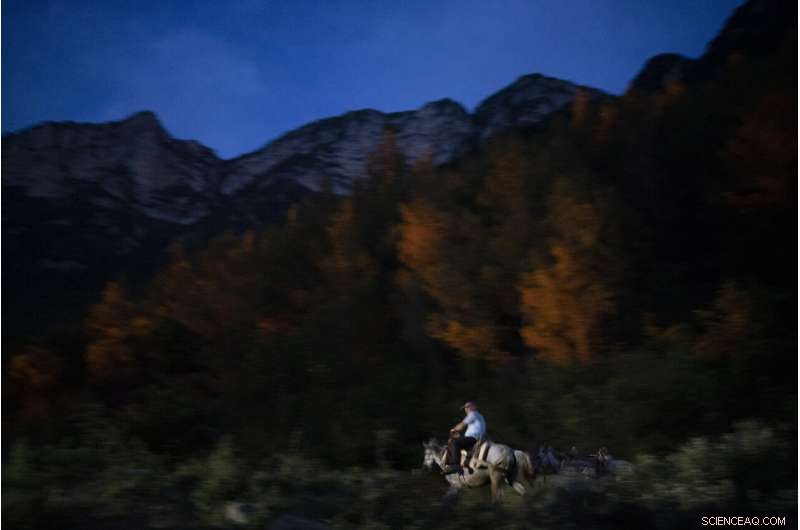
In this June 22, photographies 2019, Jonuz Jonuzi, 70, rides his horse on the banks of the Vjosa River in the Kelcyre Gorge, Albania. He raised his children here and now watches his grandchildren play in the Vjosa's waters. Before dawn each day, he crosses a bridge over a narrow gorge to tend to his goats before his son drives them to drink from a local spring, where the water emerges cold and crystal clear. "Everything I have, I have because of the river, " he says. "Albania needs electrical energy. But not by creating one thing and destroying another. Why do such damage that will be irreparable for life, that future generations will blame us for what we've done?" (AP Photo/Felipe Dana)
There are some signs in their favor. En août, the government announced it was canceling a project in central Albania's Holta Canyon near the town of Gramsh, and would tear down part of a dam that's already built. The Infrastructure and Energy Ministry said in a statement the decision came after discussions with residents and an environmental review. Energy ministry officials rejected multiple interview requests to discuss the Vjosa River and the country's hydropower plans.
Could the Vjosa projects also be stopped?
Jonus Jonuzi, a 70-year-old farmer who grew up along the river, still has hope.
He raised his children here and now watches his grandchildren play in its waters. Before dawn each day, he crosses a bridge over a narrow gorge to tend to his goats before his son drives them to drink from a local spring, where the water emerges cold and crystal clear.
"Everything I have, I have because of the river, " he says. "Albania needs electrical energy. But not by creating one thing and destroying another. Why do such damage that will be irreparable for life, that future generations will blame us for what we've done?"
© 2019 La Presse Associée. Tous les droits sont réservés.